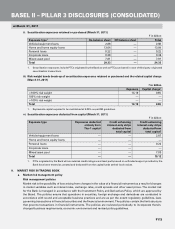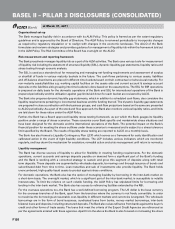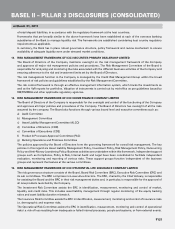ICICI Bank 2011 Annual Report Download - page 200
Download and view the complete annual report
Please find page 200 of the 2011 ICICI Bank annual report below. You can navigate through the pages in the report by either clicking on the pages listed below, or by using the keyword search tool below to find specific information within the annual report.
F122
BASEL II – PILLAR 3 DISCLOSURES (CONSOLIDATED)
at March 31, 2011
The risk management model of the organisation comprises a four stage continuous cycle, namely identification and
assessment, measurement, monitoring and control of risks. The Company has in place a Risk Management Policy which
details the strategy and procedure adopted to follow the risk management cycle at the enterprise level. A risk report
detailing the key risk exposures faced by the Company and mitigation measures is placed before the BRC on a periodic
basis.
16. RISK MANAGEMENT FRAMEWORK OF ICICI LOMBARD GENERAL INSURANCE COMPANY LIMITED
The risk management framework of the Company is overseen by the Risk Management Committee (Risk Committee) of
the Board. The framework is broadly structured as follows:
• Risk identification, assessment and mitigation process
• Risk management and oversight structure
• Risk monitoring and reporting mechanism
As part of the Enterprises Risk Management exercise, critical risks along with the detailed mitigation plan have been
presented to the Risk Committee. The risk mitigation plans are monitored regularly by the Company to ensure their
timely and appropriate execution. A Risk Register is maintained to capture inventory of risks that the Company is
exposed to along with mitigation and corrective action plans. The Risk Committee is updated on the progress on a
quarterly basis.
The senior management of the Company is responsible for periodic review of the risk management process to ensure
that the process initiatives are aligned to the desired objectives. The Management Reassurance Function is responsible
for review of risk management processes within the Company and for the review of self-assessments of risk management
activities. Further, compliance testing is done on a periodic basis and the Risk Committee is kept appraised of the
outcome of the same.
The Company’s reinsurance program defines the retention limit for various classes of products. Further, the Company
has in place a retention reinsurance philosophy which defines the product-wise retention limits on a per risk basis as
well as a retention limit on a per event basis. The Underwriting Policy defines product-wise approval limits for various
underwriters. The Investment Policy lays down the asset allocation strategy to ensure financial liquidity, security and
diversification. The Capital Adequacy and Liquidity Management Policy covers maintenance of adequate level of capital
at all times to meet diverse risk related to market and operations.
17. RISK MANAGEMENT FRAMEWORK OF ICICI SECURITIES LIMITED
The Board of Directors of ICICI Securities has constituted a Risk Management Committee (RMC) for identifying and
assessing risks, framing risk management policies and methodologies, ensuring compliance of the same, managing
various risks, analysing and monitoring various products/processes/policies from an operational risk perspective and
suggesting risk controls to ensure that the residual risk of various business activities is within tolerable limits. The RMC
meets at least once in a quarter.
The risk management function in the Company is performed by the Internal Controls team within the broad framework
as contained in the Corporate Risk and Investment Policy (CRIP). The CRIP is approved by the RMC. The Corporate Risk
Management Group along with Operations Risk Management Group aims at anticipating risks, proactively planning for
managing such risks and being better equipped for handling/managing any uncertainties.
The finance team works under the broad framework of Asset Liability Management Policy to ensure maintenance of
adequate level of economic capital at all times.
Further, the following board-constituted committees also contribute to the operational efficiency and risk management
of the company:
a. Audit Committee.
b. Product & Processes Approval Committee (PAC)
c. Compliance Committee
d. Investment Committee
e. Commitment Committee
f. Information Technology (IT) Risk & Customer Service Committee


















